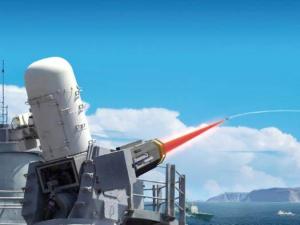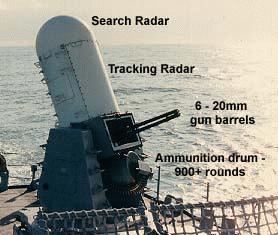
A Rendering of Raytheon’s Laser Weapon System
A Raytheon-U.S. Navy team is working to add a solid-state laser to the Phalanx Close-in Weapon System.
Raytheon
Raytheon revealed its next-gen directed energy weapon at the Farnborough Air Show, releasing video showing its Laser Weapons System (LaWS) — a six-laser weapon that focuses on a single target — engaging and then destroying an unmanned aerial vehicle (drone) from the deck of a Navy vessel at sea.
The tests conducted show the LaWS illuminating and then heating the underside of a drone aircraft shortly before it goes up in flames and loses trajectory, plummeting into the ocean below. Guided by Raytheon’s Laser Close-in Weapon System (CIWS), a sensor suite that locks onto and guides the energy weapon, LaWS shot down three similar drones during the tests, which marked the first time a solid-state laser has shot down an aircraft on the wing over open seas.
There are three significant parts to this story. First, it’s important to note that LaWS is a solid-state laser rather than a chemical laser, which means “it’s not quite so hazardous” to handle and requires less energy to use. It’s also smaller, which makes it a lot more feasible to pack onto a naval vessel. Second, solid-state lasers are generally weaker than chemical lasers, and that problem is compounded by the moist air in ocean climates, as that moisture can absorb laser energy and weaken the beam. So proving this solid-state technology can work at sufficient strengths over the ocean is a serious milestone.
But most importantly, Raytheon demonstrated that a laser integrated into the Navy’s Phalanx Weapons System – US Military a weapons system already mounted on many naval vessels — can hit a moving target from the deck of a ship, which itself is moving and rolling along with the ocean. That’s pretty sharp shooting, and it could arm U.S. seamen with a greatly enhanced last line of defense during aerial and ballistic missile warfare at sea.
Of course, what works on a moving naval platform also works from stationary, land-based positions, and Raytheon is also looking to mount the system on trailers much as Boeing has done with its Mobile Active Targeting Resource for Integrated experiments (MATRIX).
That system, along with some of Boeing’s other directed energy systems, shot down several UAVs last year. But if Raytheon can do it in a smaller, less energy-intensive package the military might find that more compact solid-state lasers are the future.
Check out the CIWS roasting a drone below.
The US military have successfully, developed, tested and installed the new Laser Weapon System (LaWS) to Navy ships which is capable of taking down unmanned enemy drones [and other platforms], making for more efficient management of weapons resources on a limited sized ship.
The weapon uses directed laser energy to burn targets, which could be used to expose fuel lines in an enemy plane or ship, damaging it critically or even destroying it.
Tests in desert and sea environments show that it is capable of destroying enemy drones, saving weapons resources for other targets.
The weapon was developed by The Directed Energy Weapons Office (DEWO), a subsidiary of Naval Sea Systems Command (NAVSEA) Warfare Centers Dahlgren along with Raytheon Corporation (a company putting massive investment in directed energy weapon research)
The Pentagon has struggled for years to develop effective laser weapons systems, including ones mounted on planes intended to shoot down missiles. The Naval version, the first of its kind to be dispatched to the field.
Military officials said the Persian Gulf was also an important “testing ground” because of its harsh physical environment.
“If it can stand up to the weather and rugged nature it can do it anywhere,” said one Navy official.
The U.S. military is wary of the threat posed by small attack boats. In 2000, a small boat filled with explosives hit the USS Cole in Yemen, killing 17 sailors.
Resources:
-
Raytheon Company: From the Laboratory to the Practice Range …
-
Phalanx Weapons System – US Military
-
Video: Raytheon’s Ship-Mounted Laser Weapon Incinerates a UAV …
-
Directed–energy weapons will be the next generation
-
Directed Energy Warfare Office
-
Close-In Weapons System (CIWS) – U.S. Navy
-
Warfare Centers – Dahlgren – Naval Sea Systems Command
-
Air Force Seeks Laser Weapons for Next Generation Fighters | USNI …
-
Laser Weapon System (LaWS)
-
Update: MATRIX Tactical Laser Weapon Demonstrates Counter
Related articles
- Air Force Seeks Laser Weapons for Next Generation Fighters (news.usni.org)
- Drone-Mounted Laser Weapons Are on the Way (motherboard.vice.com)
- New Radar from RADA to Guide Boeing’s Laser Weapons (defense-update.com)
- Wanted: A New “Star Wars” Laser Gun for DARPA (fool.com)
- DARPA Plans to Arm Drones With Missile-Blasting Lasers (nextbigfuture.com)
- US Air Force fighter jets will have laser weapons by 2030 (sploid.gizmodo.com)
- Star Wars Era to come: US Air Force to employ laser cannons on jets by 2030 (theaviationist.com)
- Drone-Mounted Laser Weapons Are on the Way (wchildblog.com)

Pingback: Lasers As Weapons | Back Country Voices
Reblogged this on lisaleaks and commented:
Of course, what works on a moving naval platform also works from stationary, land-based positions, and Raytheon is also looking to mount the system on trailers much as Boeing has done with its Mobile Active Targeting Resource for Integrated experiments (MATRIX).
The weapon uses directed laser energy to burn targets, which could be used to expose fuel lines in an enemy plane or ship, damaging it critically or even destroying it.
LikeLike
Pingback: People Cooking Explained | Surviving Each Moment - Tortured World Hidden Evil
Pingback: Naval Directed-Energy Weapons — No Longer A Future Weapon Concept | Back Country Voices